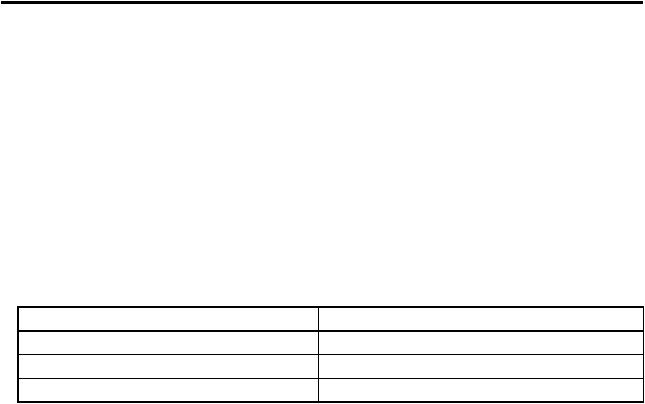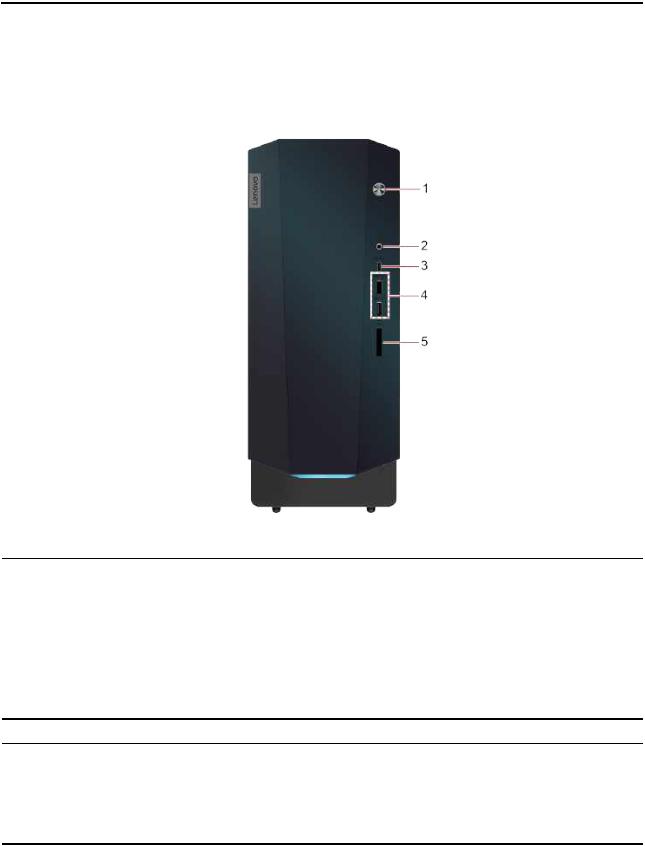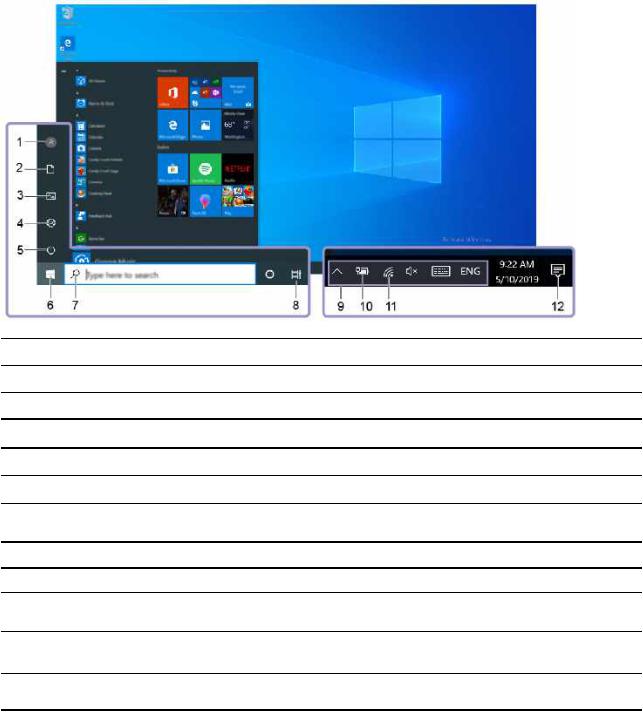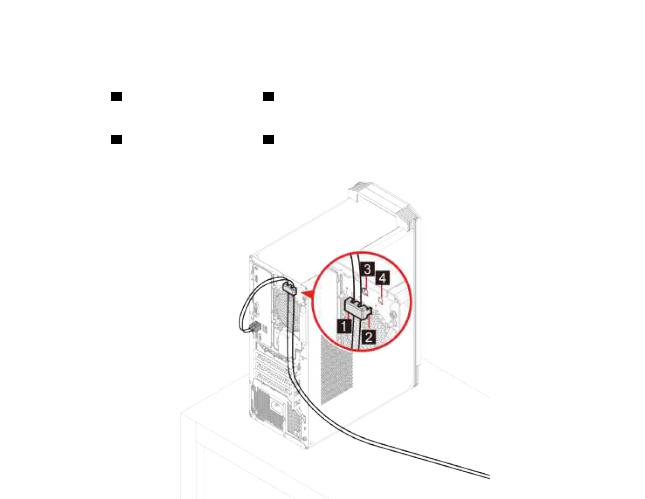Lenovo IdeaCentre G5 14AMR05 90Q10035MH, IdeaCentre G5 14IMB05 90N900BEMH, Legion T5 28IMB05 90NC00J8MH User manual

User Guide
IdeaCentre Gaming 5 (14L, 05)
IdeaCentre Creator 5 (14L, 05)
Read this first
Before using this documentation and the product it supports, ensure that you read and understand the following:
•Appendix A “Important safety information” on page 61
•Safety and Warranty Guide
•Setup Guide
First Edition (August 2020)
© Copyright Lenovo 2020.
LIMITED AND RESTRICTED RIGHTS NOTICE: If data or software is delivered pursuant to a General Services Administration “GSA” contract, use, reproduction, or disclosure is subject to restrictions set forth in Contract No. GS- 35F-05925.

Contents
About this documentation . . . . . . . .iii
Chapter 1. Meet your computer . . . . . 1
Front . . . . . . . . . . . . . . . . . . . . 1 Rear . . . . . . . . . . . . . . . . . . . . 3
Features and specifications . . . . . . . . . . . 5 Statement on USB transfer rate . . . . . . . . 5
Chapter 2. Get started with your computer . . . . . . . . . . . . . . . . . 7
Get started with Windows 10 . . . . . . . . . |
. |
7 |
Windows account . . . . . . . . . . . . |
. |
7 |
Windows user interface . . . . . . . . . . |
. |
8 |
Connect to networks . . . . . . . . . . . . . |
. |
9 |
Connect to the wired Ethernet . . . . . . . |
. |
9 |
Connect to Wi-Fi networks. . . . . . . . . |
. |
9 |
Use Lenovo Vantage . . . . . . . . . . . . . |
. |
9 |
Use multimedia . . . . . . . . . . . . . . . |
|
10 |
Use audio . . . . . . . . . . . . . . . |
|
10 |
Chapter 3. Explore your computer . . |
11 |
Manage power . . . . . . . . . . . . . . . |
11 |
Set power button behaviors . . . . . . . . |
11 |
Set the power plan . . . . . . . . . . . . |
11 |
Transfer data . . . . . . . . . . . . . . . . |
11 |
Connect to a Bluetooth-enabled device. . . . |
11 |
Use a media card . . . . . . . . . . . . |
12 |
Use a smart cable clip . . . . . . . . . . . . |
12 |
Lock the computer . . . . . . . . . . . . . |
13 |
Purchase accessories . . . . . . . . . . . . |
14 |
Chapter 4. Troubleshooting, |
|
diagnostics, and recovery . . . . . . . |
15 |
Basic procedure for resolving computer |
|
problems . . . . . . . . . . . . . . . . . |
15 |
Troubleshooting . . . . . . . . . . . . . . |
15 |
Startup problems . . . . . . . . . . . . |
16 |
Audio problems . . . . . . . . . . . . . |
17 |
Network problems . . . . . . . . . . . . |
17 |
Performance problems . . . . . . . . . . |
20 |
Storage drive problems . . . . . . . . . . |
21 |
Software problems . . . . . . . . . . . . |
21 |
Recovery . . . . . . . . . . . . . . . . . |
21 |
Restore system files and settings to an earlier |
|
point . . . . . . . . . . . . . . . . . |
21 |
Restore your files from a backup . . . . . . |
21 |
Reset your computer . . . . . . . . . . . |
22 |
Use advanced options . . . . . . . . . . |
22 |
Windows automatic recovery. . . . . . . . |
22 |
Create and use a recovery USB device . . . . 22 |
|
Update the device driver . . . . . . . . . |
23 |
Chapter 5. CRU replacement . . . . . |
25 |
What are CRUs . . . . . . . . . . . . . . . |
25 |
Replace a CRU . . . . . . . . . . . . . . . |
26 |
Power cord. . . . . . . . . . . . . . . |
26 |
Computer cover . . . . . . . . . . . . . |
27 |
Front bezel . . . . . . . . . . . . . . . |
29 |
2.5-inch storage drive (for selected models) . . 32 |
|
Storage drive bay . . . . . . . . . . . . |
34 |
3.5-inch storage drive . . . . . . . . . . |
40 |
Storage drive rubber . . . . . . . . . . . |
42 |
M.2 solid-state drive . . . . . . . . . . . |
43 |
Memory modules . . . . . . . . . . . . |
44 |
Microprocessor heatsink and fan assembly . . |
47 |
PCI-Express card . . . . . . . . . . . . |
48 |
PCI-Express card holder . . . . . . . . . |
51 |
Coin-cell battery. . . . . . . . . . . . . |
52 |
Power supply assembly . . . . . . . . . . |
54 |
Chapter 6. Help and support . . . . . |
57 |
Self-help resources . . . . . . . . . . . . . |
57 |
Call Lenovo . . . . . . . . . . . . . . . . |
58 |
Before you contact Lenovo . . . . . . . . |
58 |
Lenovo Customer Support Center . . . . . . |
58 |
Purchase additional services. . . . . . . . . . |
59 |
Appendix A. Important safety information . . . . . . . . . . . . . . . 61
Appendix B. Accessibility and ergonomic information . . . . . . . . 75
Appendix C. Compliance
information . . . . . . . . . . . . . . . 79
Appendix D. Notices and
trademarks . . . . . . . . . . . . . . . 91
© Copyright Lenovo 2020 |
i |
ii User Guide

About this documentation
•Depending on the model, some optional accessories, features, and software programs might not be available on your computer.
•Depending on the version of the operating systems and programs, some user interface instructions might not be applicable to your computer.
•Documentation content is subject to change without notice. Lenovo makes constant improvements to the
documentation of your computer, including this User Guide To get the latest documentation, go to: |
. |
https://pcsupport.lenovo.com
•Microsoft® makes periodic feature changes to the Windows® operating system through Windows Update. As a result, some information in this documentation might become outdated. Refer to Microsoft resources for the latest information.
•This guide applies to the Lenovo product models listed below. Illustrations in this guide may look slightly different from your product model.
Model name |
|
Machine types (MT) |
IdeaCentre G5 |
14IMB05 |
90NR, 90N9 |
IdeaCentre G5 |
14AMR05 |
90Q0, 90Q1 |
IdeaCentre C5 14IMB05 |
90R7, 90R8 |
|
© Copyright Lenovo 2020 |
iii |
iv User Guide

Chapter 1. Meet your computer
Front
1.Power button
2.Headset connector
3.USB-C™ connector (USB 3.2 Gen 1)
 Power and then select
Power and then select
.
The indicator in the power button shows the system status of your computer.
•On: The computer is on.
•Off: The computer is off or in hibernation mode.
•Blinking: The computer is in sleep mode.
Connect a headset or headphones to your computer.
•Charge USB-C compatible devices with the output voltage and current of 5 V and 3 A.
•Transfer data at USB 3.2 Gen 1 speeds, up to 5 Gbps.
•Connect to USB-C accessories to help expand your computer functionality. To purchase USB-C accessories, go to https://www.lenovo.com/accessories.
© Copyright Lenovo 2020 |
1 |

4. USB 3.2 connectors Gen 1 (2)
5. SD-card slot*
* for selected models
Connect USB-compatible devices, such as a USB keyboard, USB mouse, USB storage device, or USB printer.
Supported cards:
•Secure Digital (SD) card
•Secure Digital eXtended-Capacity (SDXC) UHS-1 card
•Secure Digital High-Capacity (SDHC) UHS-1 card
Notes:
•Your computer does not support the content protection for recordable media (CPRM) feature for the SD card.
See “Use a media card” on page 12.
2 User Guide

Rear
1. Audio line-out connector
2. HDMI 1.4 out connector
3.VGA-out connector
4.USB 2.0 connectors (4)
5.Ethernet connector
6.Wireless antennas
Send audio signals from the computer to external devices, such as powered stereo speakers, headphones, or multimedia keyboards. To connect a stereo system or other external recording device, connect a cable between the audio line-in connector of the device and the audio line-out connector of the computer.
Note: If your computer has both an audio line-out connector and a headset or headphone connector, always use the headset or headphone connector for earphones, headphones, or a headset. The headphone connector does not support headset microphones.
Send audio and video signals from the computer to another audio or video device, such as a high-performance™ monitor. For more information, see https:// www.hdmi.org/manufacturer/hdmi_1_4/index.aspx.
Send video signals from the computer to another video device, such as a monitor.
Connect USB-compatible devices, such as a USB keyboard, USB mouse, USB storage device, or USB printer.
Connect to a local area network (LAN). When the indicator is on, the computer is connected to a LAN. When the indicator blinks, data is being transmitted.
Send and receive radio waves for the wireless LAN/Bluetooth module.
Note: The antennas are not visible from the outside of the computer.
Chapter 1. Meet your computer 3

7.PCI-Express card area
8.Power cord connector
9.Padlock loop
10.Security lock slot
Install PCI-Express cards into this area to improve the operating performance of the computer. Depending on the computer model, the connectors in this area vary.
Note: A discrete graphics card can be installed in the appropriate Peripheral Component Interconnect Express (PCIe) card slot. If such a card is installed, be sure to use the connectors on the card instead of the corresponding connectors on the computer.
Connect the power cord to your computer for power supply.
Lock the computer cover using a padlock.
Lock your computer to a desk, table, or other fixtures using a Kensington-style cable lock.
4 User Guide

Features and specifications
Hardware configuration
Power supply
Microprocessor
Memory
Storage device
Expansion
Network features
1.Right-click the Start button to open the Start context menu.
2.Click Device Manager Type the administrator password or provide confirmation if prompted.
•260 W automatic voltage-sensing power supply
•310 W automatic voltage-sensing power supply
•380 W automatic voltage-sensing power supply
To view the microprocessor information of your computer, right-click the Start
button and then click System . Double data rate 4 (DDR4) dual in-line memory module (DIMM).
To view the storage drive capacity of your computer, right-click the Start button to open the Start context menu and then click Disk Management
Note: The storage drive capacity indicated by the system is less than the nominal capacity.
•SD card slot*
•DDR4 DIMM slots
•M.2 solid-state drive slot (2280)
•Storage drive bays
–2.5-inch Storage drive bay
–3.5-inch Storage drive bay
•Bluetooth
•Gigabit Ethernet LAN
•Wireless LAN
* for selected models
Statement on USB transfer rate
Depending on many factors such as the processing capability of the host and peripheral devices, file attributes, and other factors related to system configuration and operating environments, the actual transfer rate using the various USB connectors on this device will vary and will be slower than the data rate listed below for each corresponding device.
USB device |
Data rate (Gbit/s) |
3.1 Gen 1/3.2 Gen 1 |
5 |
3.1 Gen 2/3.2 Gen 2 |
10 |
3.2 Gen 2 × 2 |
20 |
Chapter 1. Meet your computer 5
6 User Guide

Chapter 2. Get started with your computer
Get started with Windows 10
Learn the basics of Windows 10 and start working with it right away. For more information about Windows 10, see the Windows help information.
Windows account
A user account is required to use the Windows operating system. It can either be a Windows user account or a Microsoft account.
Windows user account
When you start Windows for the first time, you are prompted to create a Windows user account. This first account you created is of the “Administrator” type. With an Administrator account, you can create additional user accounts or change account types by doing the following:
1.Open the Start menu and select Settings Accounts Family & other users
2.Follow the on-screen instructions.
Microsoft account
You can also log in to the Windows operating system with a Microsoft account.
To create a Microsoft account, go to the Microsoft sign-up page at https://signup.live.com and follow the onscreen instructions.
With a Microsoft account, you can:
•Enjoy one-time signing in if you are using other Microsoft services, such as OneDrive, Skype, and Outlook. com.
•Sync personalized settings across other Windows-based devices.
© Copyright Lenovo 2020 |
7 |

Windows user interface
1.Account 
2.Documents 
3.Pictures 
4.Settings 
5.Power 
6.Start button 
7.Windows Search 
8.Task View 
9.Windows notification area
10.Battery status icon
11.Network icon
12.Action center 
Open the Start menu
• Click the Start button.
Change account settings, lock the computer, or sign out from the current account.
Open the Documents folder, a default folder to save your received files.
Open the Pictures folder, a default folder to save your received pictures.
Launch Settings.
Shut down, restart, or put the computer into sleep mode.
Open the Start menu.
Type what you are looking for in the search box and get search results from your computer and the Web.
Display all opened apps and switch among them.
Display notifications and status of some features.
Display power status and change battery or power settings. When your computer is not connected to ac power, the icon changes to  .
.
Connect to an available wireless network and display the network status. When connected to a wired network, the icon changes to  .
.
Display the latest notifications from apps and provide quick access to some features.
• Press the Windows logo key on the keyboard.
Open the Start context menu
Right-click the Start button.
8 User Guide

Access Control Panel
•Open the Start menu and click Windows System Control Panel
•Use Windows Search.
Launch an app
•Open the Start menu and select the app you want to launch.
•Use Windows Search.
Connect to networks
Your computer helps you connect to the world through a wired or wireless network.
Connect to the wired Ethernet
Connect your computer to a local network through the Ethernet connector on your computer with an Ethernet cable.
Connect to Wi-Fi networks
1.Click the network icon in the Windows notification area. A list of available wireless networks is displayed.
2.Select a network available for connection. Provide required information, if needed.
Use Lenovo Vantage
The preinstalled Lenovo Vantage is a customized one-stop solution to help you maintain your computer with automated updates and fixes, configure hardware settings, and get personalized support.
Access Lenovo Vantage
Open the Start menu and click Lenovo Vantage You also can type Lenovo Vantage in the search box.
To download the latest version of Lenovo Vantage, go to Microsoft Store and search by the app name.
Key features
Lenovo Vantage enables you to:
•Know the device status easily and customize device settings.
•Download and install UEFI BIOS, firmware and driver updates to keep your computer up-to-date.
•Monitor your computer health, and secure your computer against outside threats.
•Look up warranty status (online).
•Access User Guide and helpful articles.
Notes:
•The available features vary depending on the computer model.
•Lenovo Vantage makes periodic updates of the features to keep improving your experience with your computer. The description of features might be different from that on your actual user interface.
Chapter 2. Get started with your computer 9

Use multimedia
Use your computer for business or entertainment with connected devices (such as a camera, a monitor, or speakers).
Use audio
To enhance the audio experience, connect speakers, headphones, or a headset to the audio connector.
Adjust the volume
1.Click the volume icon in the Windows notification area on the taskbar.
2.Follow the on-screen instructions to adjust the volume. Click the speaker icon to mute the audio.
Change the sound settings
1. Go to Control Panel and view by category.
2. Click Hardware and Sound Sound |
. |
3. Change the settings as you prefer.
10 User Guide

Chapter 3. Explore your computer
Manage power
Use the information in this section to achieve the best balance between performance and power efficiency.
Set power button behaviors
You can define what the power button does according to your preference. For example, by pressing the power button, you can turn off the computer or put the computer to sleep or hibernation mode.
To change what the power button does:
1. Go to Control Panel and view by large icons or small icons.
2. Click Power Options Choose what the power buttons do |
. |
3. Change the settings as you prefer.
Set the power plan
For ENERGY STAR® compliant computers, the following power plan takes effect when your computers have been idle for a specified duration:
Table 1. Default power plan (when plugged into ac power)
•Turn off the display: After 10 minutes
•Put the computer to sleep: After 25 minutes
To awaken the computer from Sleep mode, press any key on your keyboard.
To reset the power plan to achieve the best balance between performance and power saving:
1. Go to Control Panel and view by large icons or small icons.
2. Click Power Options and then choose or customize a power plan of your preference. |
, |
Transfer data
Quickly share your files using the built-in Bluetooth technology among devices with the same features. You also can install a disc or media card to transfer data.
Connect to a Bluetooth-enabled device
You can connect all types of Bluetooth-enabled devices to your computer, such as a keyboard, a mouse, a smartphone, or speakers. To ensure that the connection is successful, place the devices 10 meters (33 feet), at most, from the computer.
1.Turn on Bluetooth on the computer.
a.Open the Start menu, and then click Settings Devices Bluetooth & other devices
b.Turn on the Bluetooth switch.
2.Click Add Bluetooth or other device Bluetooth
3.Select a Bluetooth device, and then follow the on-screen instructions.
© Copyright Lenovo 2020 |
11 |

Your Bluetooth device and computer will automatically connect the next time if the two devices are in range of each other with Bluetooth turned on. You can use Bluetooth for data transfer or remote control and communication.
Use a media card
If your computer has a SD-card slot, read the following information.
Install a media card
1.Locate the SD-card slot.
2.Ensure that the metal contacts on the card are facing the ones in the SD-card slot. Insert the card firmly into the SD-card slot until it is secured in place.
Remove a media card
Attention: Before removing a media card, eject the card from the Windows operating system first. Otherwise, data on the card might get corrupted or lost.
1.Click the triangular icon in the Windows notification area to show hidden icons. Then, right-click the
Safely Remove Hardware and Eject Media icon.
2.Select the corresponding item to eject the card from the Windows operating system.
3.Press the card and remove it from your computer. Store the card safely for future use.
Use a smart cable clip
Note: You can purchase a smart cable clip from Lenovo.
Lock devices (such as the keyboard and the mouse) to your computer through a smart cable clip.
1.Insert the clip 1 into the cable-lock slot 3 .
2.Pull the cables you want to lock through the dents in the smart cable clip.
3.Press the clip 2 into the cable-lock slot 4 until it snaps into position.
12 User Guide

Lock the computer
Note: You are responsible for evaluating, selecting, and implementing the locking device and security feature. Lenovo makes no comments, judgments, or warranties about the function, quality, or performance of the locking device and security feature. You can purchase computer locks from Lenovo.
Padlock
Locking the computer cover through a padlock prevents unauthorized access to the inside of your computer.
Chapter 3. Explore your computer 13

Kensington-style cable lock
Lock your computer to a desk, table, or other fixtures through a Kensington-style cable lock.
Purchase accessories
Lenovo has a number of hardware accessories and upgrades to help expand the capabilities of your computer. Options include memory modules, storage devices, network cards, power adapters, keyboards, mice, and more.
To shop at Lenovo, go to https://www.lenovo.com/accessories.
14 User Guide

Chapter 4. Troubleshooting, diagnostics, and recovery
This chapter provides solutions to resolve computer problems. Use the basic procedure as a starting point for resolving computer problems.
Basic procedure for resolving computer problems
Prerequisite
Before you start, read Appendix A “Important safety information” on page 61 and print the following instructions.
1.Check that:
a.The cables for all connected devices are connected correctly and securely.
b.All components have been reassembled correctly.
c.All connected devices that require ac power are connected to properly grounded and working electrical outlets.
d.All connected devices are enabled in UEFI BIOS.
2.Use an antivirus program to see if the computer has been infected by a virus. If the program detects a virus, remove the virus.
3.Go to “Troubleshooting” on page 15 and follow the instructions for the type of problem you are experiencing.
4.Recover your operating system. See “Recovery” on page 21.
5.If the problem persists, contact Lenovo. See Chapter 6 “Help and support” on page 57.
Troubleshooting
Use the troubleshooting information to find solutions to problems that have definite symptoms.
© Copyright Lenovo 2020 |
15 |

Startup problems
Problem
The computer does not start up when you press the power button.
The operating system does not start up from the correct storage drive or fails to start up
The computer beeps multiple times before the operating system starts up.
Solution
•Ensure that the power cord is correctly connected to the rear of the computer and to a working electrical outlet.
•If the computer has a secondary power switch on the rear of the computer, ensure that it is switched on.
•The power indicator on the front of the computer is on.
•The computer voltage matches the voltage available at the electrical outlet for your country or region.
•Ensure that all storage drive signal cables and power cables are connected correctly.
•Ensure that the storage drive the computer starts up from is listed as the first startup device in UEFI BIOS.
•In rare cases, the storage drive with the operating system might get corrupted or damaged. In such cases, you might need to replace the storage drive.
•If the computer is installed with an Optane memory:
–Ensure that the Optane memory is not removed.
–Ensure that the Optane memory is not damaged. Check the Optane memory using diagnostic tools.
Ensure that no keys are stuck.
16 User Guide

Audio problems
Problem
The audio cannot be heard on the Windows operating system.
The sound does not come from the headset or headphones.
The sound comes from one of the external speakers.
Solution
•If you are using powered external speakers that have an On/Off control, ensure that:
–The On/Off control is set to the On position.
–The speaker power cable is connected to a properly grounded, functional ac electrical outlet.
•If your external speakers have a volume control, ensure that the volume is not set too low.
•Click the volume icon in the Windows notification area on the taskbar. Check the speaker and volume settings. Do not mute the speaker or set the volume at a very low level.
•If your computer has a front audio panel, ensure that the volume is not set too low.
•Ensure that your external speakers (and headphones, if used) are connected to the correct audio connector on the computer. Most speaker cables are color-coded to match the audio connector.
Note: When external-speaker or headphone cables are connected to the audio connector, the internal speaker, if present, is disabled. In most cases, if an audio adapter is installed in one of the expansion slots, the audio function built into the system board is disabled. Therefore, you must use the audio connectors on the audio adapter.
•Ensure that the program you are running is designed for use in the Microsoft Windows operating system. If the program is designed to run in DOS, the program does not use the Windows sound feature. The program must be configured to use SoundBlaster Pro or SoundBlaster emulation.
•Ensure that the audio device drivers are correctly installed.
Select the headset or headphones as the default audio output device in advanced sound settings.
•Ensure that the speaker cable is inserted completely into the connector on the computer.
•Ensure that the cable that connects the left speaker to the right speaker is securely connected.
•Ensure that the balance settings are set correctly.
1.Right-click the volume icon in the Windows notification area on the taskbar. Then, click Open Volume Mixer and select the desired speaker.
2.Click the speaker icon on top of the volume control, and then click the Levels tab.
Network problems
Note: The Wi-Fi and Bluetooth features are optional.
Chapter 4. Troubleshooting, diagnostics, and recovery 17

Problem
The computer cannot connect to an Ethernet LAN.
When a Gigabit Ethernet model computer is used at a speed of 1000 Mbps, the Ethernet LAN connection fails or errors occur.
The Wake On LAN (WOL) feature does not work.
The Wi-Fi feature does not work.
Solution
•Connect the cable from the Ethernet connector to the RJ45 connector of the hub.
•Enable the Ethernet LAN feature in UEFI BIOS.
•Enable the Ethernet LAN adapter.
1.Go to Control Panel and view by large icons or small icons.
2.Click Network and Sharing Center Change adapter
settings |
. |
3.Right-click the Ethernet LAN adapter icon and click Enable
•Update or reinstall the Ethernet LAN driver.
•Install all networking software that is necessary for your network environment. Check with your LAN administrator for the necessary networking software.
•Set the same duplex for the switch port and the adapter. If you configured the adapter for full duplex, ensure that the switch port is also configured for full duplex. Setting a wrong duplex mode might degrade performance, cause data loss, or result in lost connections.
Connect the network cable to the Ethernet connector using Category 5 wiring and a 100 BASE-T hub/switch (not 100 BASE-X).
Enable the Wake On LAN feature in UEFI BIOS.
•Enable the Wi-Fi feature in UEFI BIOS.
•Enable all Wi-Fi devices.
1.Right-click the Start button to open the Start context menu.
2.Click Device Manager Type the administrator password or provide confirmation, if prompted.
3.Expand Network adapters to display all network devices.
4.Right-click each Wi-Fi device, and then click Enable device
•Enable the Wi-Fi feature in Windows Settings.
1.Open the Start menu.
2.Click Settings Network & Internet Wi-Fi
3.Enable the Wi-Fi feature.
•Update or reinstall the Wi-Fi driver.
18 User Guide

Problem
The Bluetooth feature does not work.
Sound does not come from the Bluetooth headset or headphones.
Solution
•Enable the Bluetooth feature in UEFI BIOS.
•Enable all Bluetooth devices.
1.Right-click the Start button to open the Start context menu.
2.Click Device Manager Type the administrator password or provide confirmation if prompted.
3.Expand Bluetooth to display all Bluetooth devices. Right-click each Bluetooth device, and then click Enable device
4.Expand Network adapters to display all network devices.
Right-click each Bluetooth device, and then click Enable |
|
device |
. |
•Turn on the Bluetooth radio.
1.Open the Start menu.
2.Click Settings Devices Bluetooth & other devices
3.Turn on the Bluetooth switch to enable the Bluetooth feature.
•Update or reinstall the Bluetooth driver.
Select the Bluetooth headset or headphones as the default audio output device in advanced sound settings.
Chapter 4. Troubleshooting, diagnostics, and recovery 19

Performance problems
Problem
Excessive fragmented files exist on the storage drives.
The free storage drive space is insufficient.
The free memory space is insufficient.
Solution
Note: Depending on the volume of the storage drives and amount of data stored on the storage drives, the disk-defragmentation process might take up to several hours.
1.Close any open programs and windows.
2.Open the Start menu.
3. Click Windows System File Explorer This PC |
. |
4.Right-click your C drive and then click Properties
5.Click the Tools tab.
6.Click Optimize Select the drive as desired, and then click
Optimize
7.Follow the on-screen instructions.
•Clean out your Inbox, Sent Items, and Deleted Items folders from your e-mail application.
•Clean up your C drive.
1. Open the Start menu.
2. Click Windows System File Explorer This PC |
. |
3.Right-click your C drive and then click Properties
4.Check the amount of free space, and then click Disk Cleanup
5.A list of unnecessary file categories is displayed. Select the
category you want to delete, and then click OK |
. |
•Disable some Windows features or remove some unnecessary programs.
1.Go to Control Panel and view by large icons or small icons.
2.Click Programs and Features
3.Do one of the following:
–To disable some Windows features, click Turn Windows features on or off Follow the on-screen instructions. .
–To remove some unnecessary programs, select the program you want to remove, and then click Uninstall/ Change or Uninstall
•Right-click a blank area on the taskbar and open Task Manager. Then, end some tasks you are not performing.
•Install additional memory modules.
20 User Guide

Storage drive problems
Problem |
Solution |
Some or all storage drives are missing from the BIOS menu.
•Ensure that the signal cables and power cables for all the storage drives are connected correctly.
•Ensure that the computer is configured correctly to support the storage drives.
–If the computer is installed with SATA storage drives, ensure that the SATA storage drive enablement module (one to five storage drives) is installed.
–If the computer is installed with SAS storage drives, ensure that the SAS storage drive enablement module (one to five storage drives) or the LSI MegaRAID SAS adapter is installed.
Software problems
Problem |
Solution |
Some programs do not work as expected.
1.Check whether the problem is caused by a program.
a.Ensure that the software is compatible with the computer. Refer to the information supplied with the software for more information.
b.Verify that other software works correctly on the computer.
c.Verify that the software you are using works on another computer.
2.If the problem is caused by a program:
• Refer to the printed documentation that comes with the program or the help system of the program.
• Update the program.
• Uninstall the program and then reinstall it. To download a program that is preinstalled on your computer, go to https:// pcsupport.lenovo.com and follow the on-screen instructions.
Recovery
This section introduces the recovery information of the Windows 10 operating system. Ensure that you read and follow the on-screen recovery instructions. The data on your computer might be deleted during the recovery process. To avoid data loss, make a backup copy of all the data that you want to keep.
Restore system files and settings to an earlier point
1.Go to Control Panel and view by large icons or small icons.
2.Click Recovery Open System Restore Then, follow the on-screen instructions.
Restore your files from a backup
Note: If you use the File History tool to restore your files from a backup, ensure that you backed up your data earlier with the tool.
1.Go to Control Panel and view by large icons or small icons.
2.Click File History Restore personal files Then, follow the on-screen instructions..
Chapter 4. Troubleshooting, diagnostics, and recovery 21
Reset your computer
In the resetting process, you can choose to keep your files or remove them when you reinstall the operating system.
Note: The items in the graphical user interface (GUI) might change without notice.
1. Open the Start menu, and then click Settings Update & Security Recovery
2. In the Reset this PC section, click Get started |
. |
3. Follow the on-screen instructions to reset your computer.
Use advanced options
1.Open the Start menu, and then click Settings Update & security Recovery
2.In the Advanced startup section, click Restart now Troubleshoot Advanced options
3.Select a preferred option, and then follow the on-screen instructions.
Windows automatic recovery
Note: Ensure that your computer is connected to ac power during the recovery process.
The Windows recovery environment on your computer operates independently from the Windows 10 operating system. It enables you to recover or repair the operating system even if the Windows 10 operating system fails to start.
After two consecutive failed boot attempts, the Windows recovery environment starts automatically. Then, you can choose repair and recovery options by following the on-screen instructions.
Create and use a recovery USB device
It is recommended that you create a recovery USB drive as early as possible as a backup for the Windows recovery programs. With the recovery USB drive, you can troubleshoot and fix the problems even if the preinstalled Windows recovery programs are damaged.
Create a recovery USB drive
Attention: The creation process deletes anything stored on the USB drive. To avoid data loss, make a backup copy of all the data that you want to keep.
1.Ensure that your computer is connected to ac power.
2.Prepare a USB drive with at least 16 GB of storage capacity. The actual USB capacity required depends on the size of the recovery image.
3.Connect the prepared USB drive to the computer.
4. Type recovery in the search box. Then, click Create a recovery drive |
. |
5.Click Yes in the User Account Control window to allow the Recovery Media Creator program to start.
6.In the Recovery Drive window, follow the on-screen instructions to create a recovery USB drive.
Use the recovery USB drive
If you cannot start your computer, go to Chapter 6 “Help and support” on page 57 first to try to solve the problem by yourself. If you still cannot start your computer, use the recovery USB drive to recover your computer.
1.Ensure that your computer is connected to ac power.
2.Connect the recovery USB drive to the computer.
22 User Guide
3.Turn on or restart the computer. When the logo screen is displayed, press F12. The Boot Menu window opens.
4.Select the recovery USB drive as the boot device.
5.Click Troubleshoot to display optional recovery solutions.
6.Select a recovery solution as desired. Then, follow the on-screen instructions to complete the process.
Update the device driver
Attention: Reinstalling device drivers will change the current configuration of the computer.
You should download the latest driver for a component when you notice poor performance from that component or when you added a component. This action might eliminate the driver as the potential cause of a problem. Download and install the latest driver by one of the following methods:
•From Lenovo Vantage:
Open Lenovo Vantage to check the available update packages. If the latest UEFI BIOS update package is available, follow the on-screen instructions to download and install the package.
•From the Lenovo Support Web site:
Go to https://pcsupport.lenovo.com and select the entry for your computer. Then, follow the on-screen instructions to download and install necessary drivers and software.
•From Windows Update:
Note: The device drivers provided by Windows Update might not be tested by Lenovo. It is recommended that you get device drivers from Lenovo.
1.Open the Start menu.
2.Click Settings Update & Security Windows Update
3.Follow the on-screen instructions.
Chapter 4. Troubleshooting, diagnostics, and recovery 23
24 User Guide
